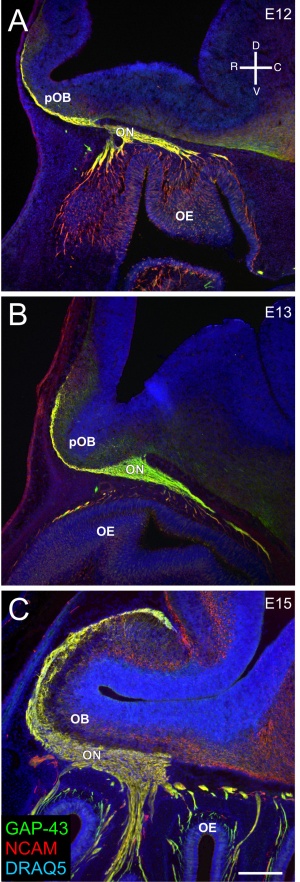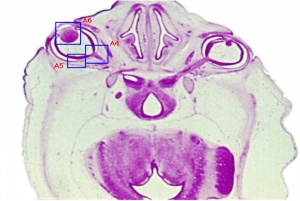Sensory - Smell Development: Difference between revisions
| Line 20: | Line 20: | ||
==Olfactory Pathway== | ==Olfactory Pathway== | ||
[[File:Mouse-olfactory_nerve_pathway_development.jpg|thumb|Mouse olfactory nerve pathway development]] | [[File:Mouse-olfactory_nerve_pathway_development.jpg|thumb|Mouse olfactory nerve pathway development<ref><pubmed>20723208</pubmed>| [http://www.neuraldevelopment.com/content/5/1/20 Neural Dev.]</ref>]] | ||
Olfactory receptor neurons (ORNs) - odours bind and activate olfactory receptors located on dendrites of sensory neurons in the nose. | Olfactory receptor neurons (ORNs) - odours bind and activate olfactory receptors located on dendrites of sensory neurons in the nose. | ||
Revision as of 15:32, 29 September 2010
Introduction
These notes introduce the development of the sense of smell or olfaction: nasal placode, olfactory epithelium, olfactory bulb, vomeronasal organ. Recent research has shown a relationship between what the receptive epithelium is exposed too and how the central neural pathway develops, similar to that shown earlier for the visual system.
A French research group has recently been investigating the development of smell in the fetus and in neonates. The nasal epithelium has also been a researh "hot topic" as it is one of the few easily accessible sites of adult neural stem cells. Note the different spellings "odour" (UK) or "odor" (USA). Anosmia is the term used to describe having no sense of smell. Anosmia/hyposmia is related to the absence or hypoplasia of the olfactory bulbs and tracts.
| Smell Links: Introduction | placode | Rhinencephalon | head | respiratory | Student project | taste | sensory | Category:Smell | ||
|
| Senses Links: Introduction | placode | Hearing and Balance hearing | balance | vision | smell | taste | touch | Stage 22 | Category:Sensory |
Some Recent Findings
|
Olfactory Receptors
Odours bind to and activate olfactory receptors located on the dendrites of sensory neurons in the nose and how the mitral cells of the olfactory bulb (OB) process olfactory information. What has yet to be thoroughly described is how the piriform cortex receives and transforms information arriving from the OB via the lateral olfactory tract (LOT). Although the cell types present in the piriform cortex are known (Shepherd, 2004), previous work has failed to differentiate between disparate electrophysiological profiles and synaptic contacts made between principal cells.
Olfactory Pathway

Olfactory receptor neurons (ORNs) - odours bind and activate olfactory receptors located on dendrites of sensory neurons in the nose.
Olfactory bulb (OB) - Mitral cells process olfactory information (encoded in a chemotopic map).
Lateral olfactory tract (LOT) - pathway to cortex.
Primary olfactory cortex (= Piriform cortex) - receives and transforms information.
Vomeronasal Accessory Olfactory System
The vomeronasal accessory olfactory system (vomeronasal organ) is involved in detecting and transfering pheromone information to the neuroendocrine hypothalamus. (More? Witt M, Hummel T., 2006 | Puberty)
Grueneberg Ganglion
The Grueneberg ganglion[3] "Within the nasal epithelium of mammals, there are several compartments which are populated with neuronal cells. One of them - the so-called Grueneberg ganglion - is composed of ciliated neurons residing in the anterior region of the nose."
Abnormalities
Anosmia
Term used to describe having no sense of smell. Anosmia/hyposmia is related to the absence or hypoplasia of the olfactory bulbs and tracts.
Kallmann Syndrome
A developmental disease affecting both the hormonal reproductive axis and the sense of smell. Affected individuals have mutations in either of two different genes KAL1 and FGFR1 (20%) and prokineticin receptor-2 (PROKR2) or prokineticin-2 (PROK2) genes (10%).
References
- ↑ <pubmed>20624980</pubmed>
- ↑ <pubmed>20723208</pubmed>| Neural Dev.
- ↑ <pubmed>20503179</pubmed>
Reviews
Articles
Search PubMed
Search Pubmed: Smell Development | olfactory receptors | Olfactory bulb development | anosmia
Glossary Links
- Glossary: A | B | C | D | E | F | G | H | I | J | K | L | M | N | O | P | Q | R | S | T | U | V | W | X | Y | Z | Numbers | Symbols | Term Link
Cite this page: Hill, M.A. (2024, May 1) Embryology Sensory - Smell Development. Retrieved from https://embryology.med.unsw.edu.au/embryology/index.php/Sensory_-_Smell_Development
- © Dr Mark Hill 2024, UNSW Embryology ISBN: 978 0 7334 2609 4 - UNSW CRICOS Provider Code No. 00098G
